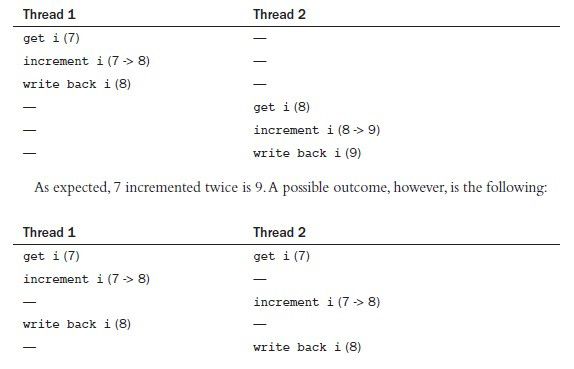Process Management
Process Management
A process is a program in execution.
The terms process and job are used almost interchangeably in most textbooks.
A process includes
- Value of program counter
- Value of registers and processor status word
- Stack for temporary variables
- Text for program code
- Data section for global variables
- Heap for dynamic storage of variables (those created using malloc)
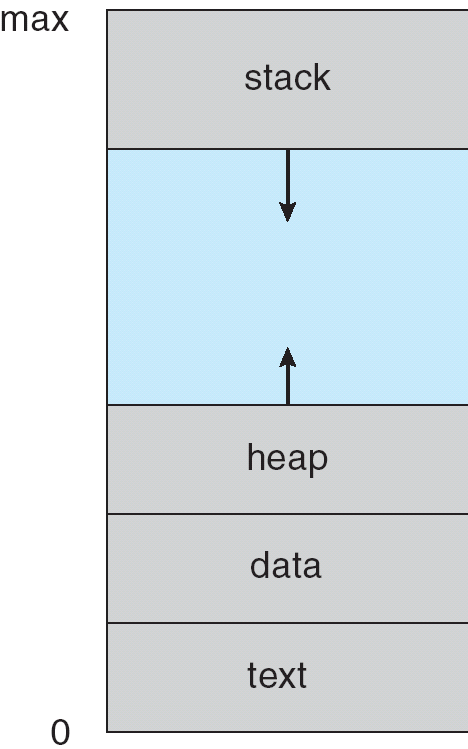
在操作系统中,有多个进程同时执行。
有些计算机系统有多个CPU,但大多数较小的计算机系统只有一个CPU。当进程的数量超过CPU的数量时,每个CPU在每个时刻只能分配给一个进程执行,不是所有的进程在任何时刻都能得到CPU的服务。进程的状态还有其他可能性。这些条件被称为进程状态。为了跟踪进程的状态,以及当进程在CPU之间切换时应该保持的信息,为每个进程分配一个数据结构。这个数据结构是进程控制块,用来存储信息(如你的书包或用户的档案/桌面)。
Process State
- new: process is being created.
- running: process is running (program instructions are being executed).
- waiting: process is waiting for some event to occur.
- ready: process is waiting to be assigned to a processor or CPU for execution.
- terminated: process has finished execution.
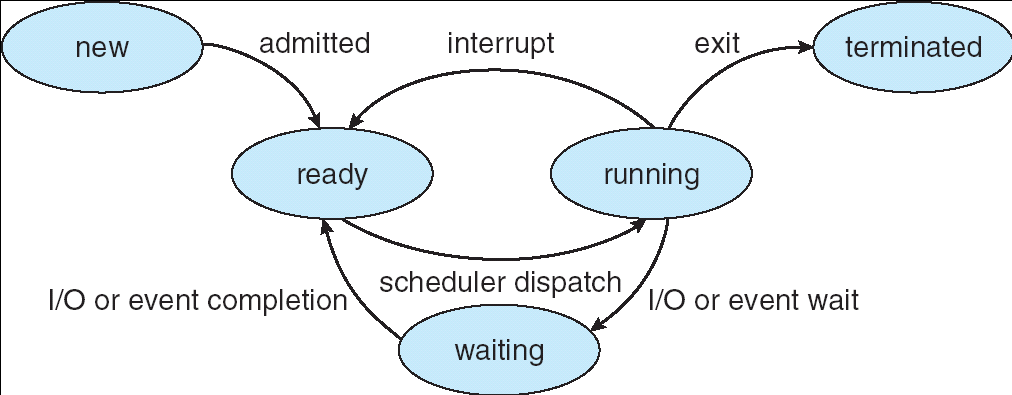
Process Control Block
Each process is represented by a Process Control Block (PCB).
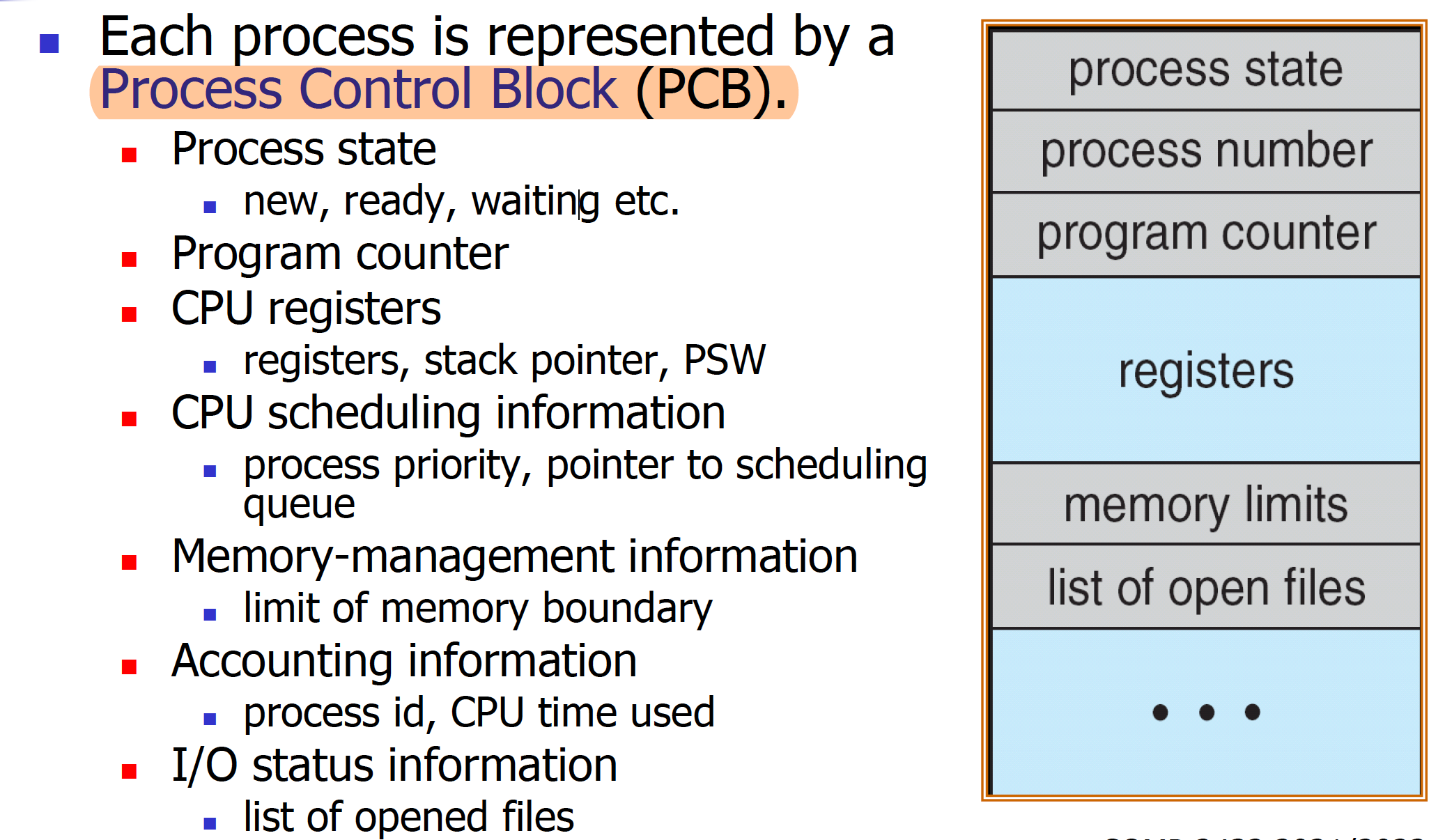
CPU Switching
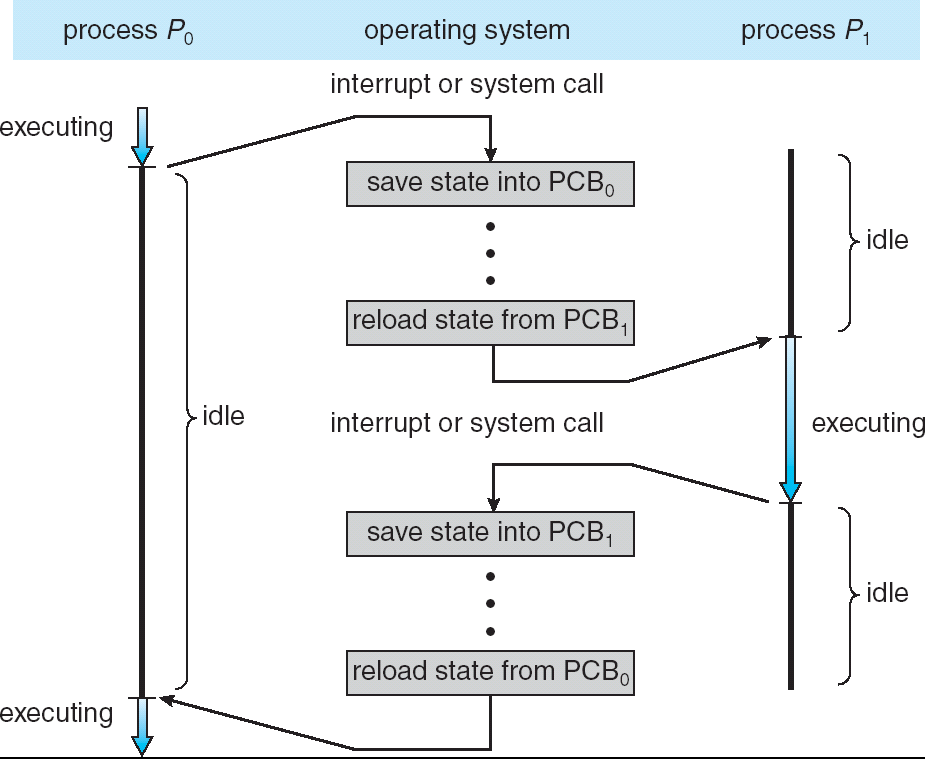
Process Scheduling Queues
Several types of queues in computer system:
- Job queue: set of all processes in the system.
- Ready queue: set of all processes residing in main memory, ready and waiting to be executed.
- Device queues: set of processes waiting for an I/O device.
Processes migrate (i.e. move) among the various queues.
预备队列中的进程获得CPU,随后可能在设备队列中等待I/O。
每种队列的进程调度器决定谁将获得下一个服务。
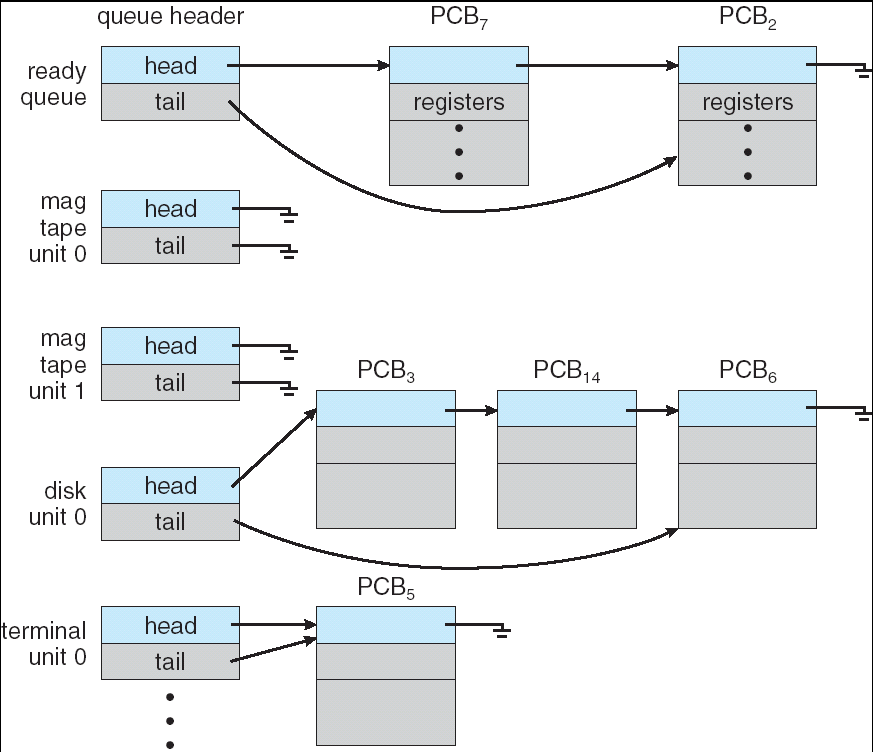
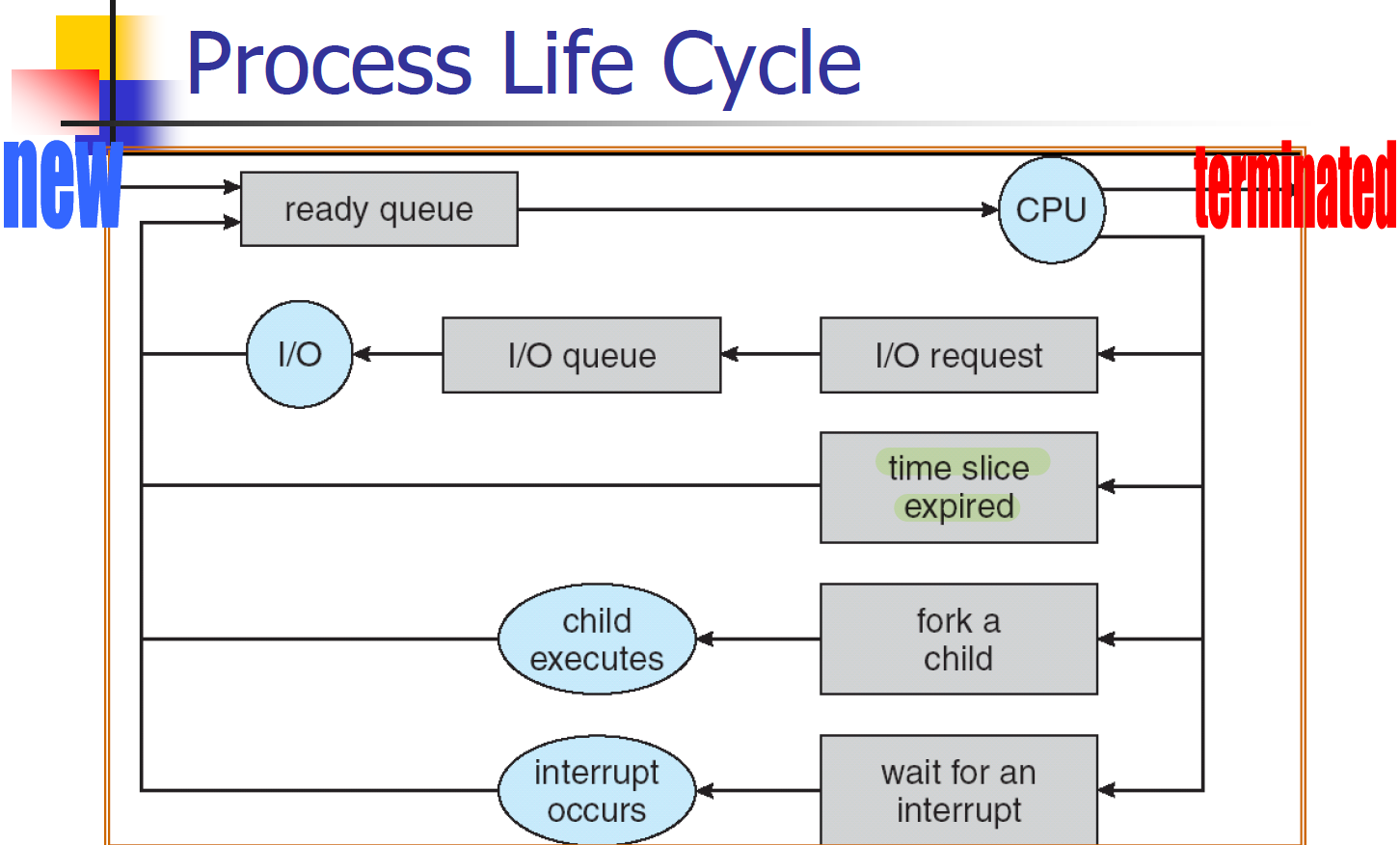
Scheduler
一个进程在其出生(创建)和死亡(终止)之间会在不同的队列中移动。当进程在等待不同的服务时,调度器会选择被服务的进程。
Long-term scheduler
Also called job scheduler.
- Select which processes should be brought into the ready queue (only process in ready queue are eligible for CPU).
- 长期调度器关注的是工作或进程的执行准入。
- 把一个进程放在准备队列中的决定很少发生,也许在进程被创建时可能发生一次。
- 决策应该是一个相当好的(它可以承受更长的运行时间)。
- 长期调度器控制多程序的程度(有可能竞争CPU的进程数量)。
Medium-term scheduler
一些系统提供了中期调度程序。
- 当有太多的进程竞争CPU时,应该从就绪队列中暂时删除一些进程。
- 当使用CPU的进程很少时,一些被删除的进程应该返回到就绪队列中。
- Control multi-programming degree after process admission.
- If not done carefully, this could lead to thrashing.

Short-term scheduler
Also called CPU scheduler.
- Select which process should be executed next and be allocated the CPU.
- 短期调度器关注的是CPU的分配。
- 给一个进程分配CPU的决定每秒钟发生很多次。
- 决策的步骤必须非常快(所以它将是简单的)。
Short-term scheduler makes decision on which process to get CPU.
- 短期调度器决定哪个进程获得CPU.
- 简单的调度器只是以先到先得的方式向CPU提交进程.
- 更好的调度器分配CPU以提高系统性能.
- 等待CPU的时间.
- 进程的完成时间.
- 响应性。
Different types of processes would need different treatment.
Processes can roughly be classified into two types:
I/O-bound process
- A process that spends more time doing I/O than computations.
- Between long duration of waiting, there are many short periods of using CPU (many short CPU bursts).
- Example: interactive programs, e.g. editor.
CPU-bound process
A process that spends more time doing computations than I/O.
Between occasional I/O, there are long periods of using CPU (few very long CPU bursts).
Example: computation programs, e.g. finding next move in chess playing.
一个进程最初可能是I/O绑定的,然后变成CPU绑定的,反之亦然。
介于I/O和CPU之间的中间进程,有适度的I/O。
A computer system will not be effective if all processes are I/O-bound. A system will not perform well if all processes are CPU-bound. Long-term scheduler makes decision to maintain a good mix of CPU-bound and I/O-bound processes. (No long-term scheduler in Unix and Windows. )
Context Switching
Short-term scheduler controls which process gets CPU next.
Sequence of events to bring CPU from an executing process to another is called context switching.
- 当CPU切换到另一个进程时,系统必须保存旧进程的状态,并为新进程加载先前保存的状态。
- 旧进程的状态将在 "time-up "中断发生时被放在堆栈中。
- 在决定了CPU的继任者之后,scheduler改变了PC,并从中断中返回到新进程。
Context switching time is a kind of overhead(开销).
- System does no useful work while switching from one process to another.
- Time cost is dependent on hardware support, e.g. amount of efforts to save the state of the old process.

Process Creation
A process is created when a program is run.
When you type a.out in Linux, the Linux shell (CLI) creates a new process for a.out, loads the code into the process and lets it run.
Processes are normally identified by an integer, called process identifier or pid.
There is a relationship between a process that creates another process.
- The creating process is called the parent process.
- The created process is called the child process.
A child process could be the parent of another process, and a tree or hierarchy of processes could be formed.
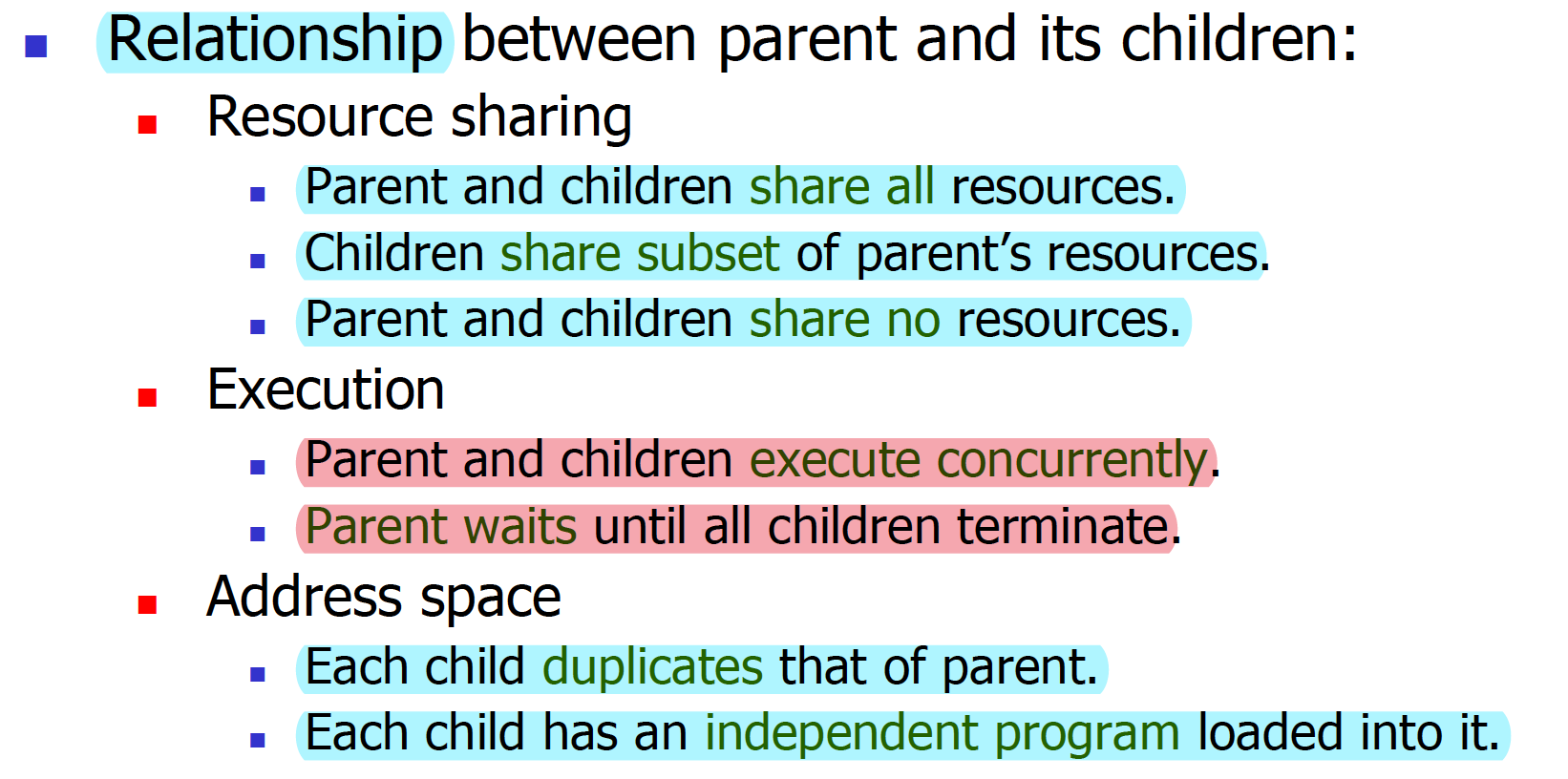
Linux example: To show the parent/children processes use -H option for ps command (does not work for Mac Unix), e.g. ps -Hlf or ps -Helf

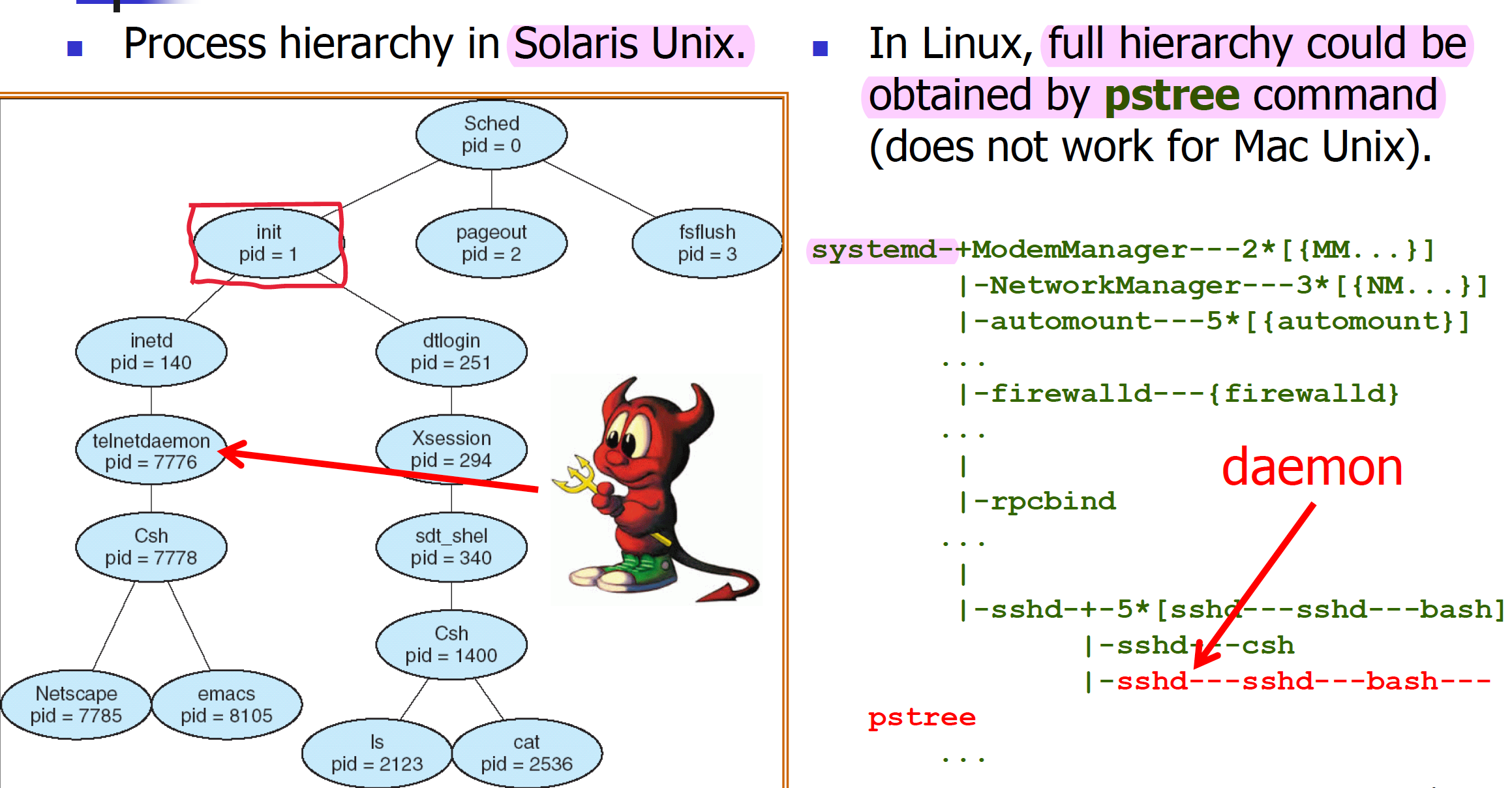
Use fork system call to create new process.
To replace process memory with a new program, use exec and its family of system calls.
Parent uses wait to collect child and then continues.

In Unix/Linux
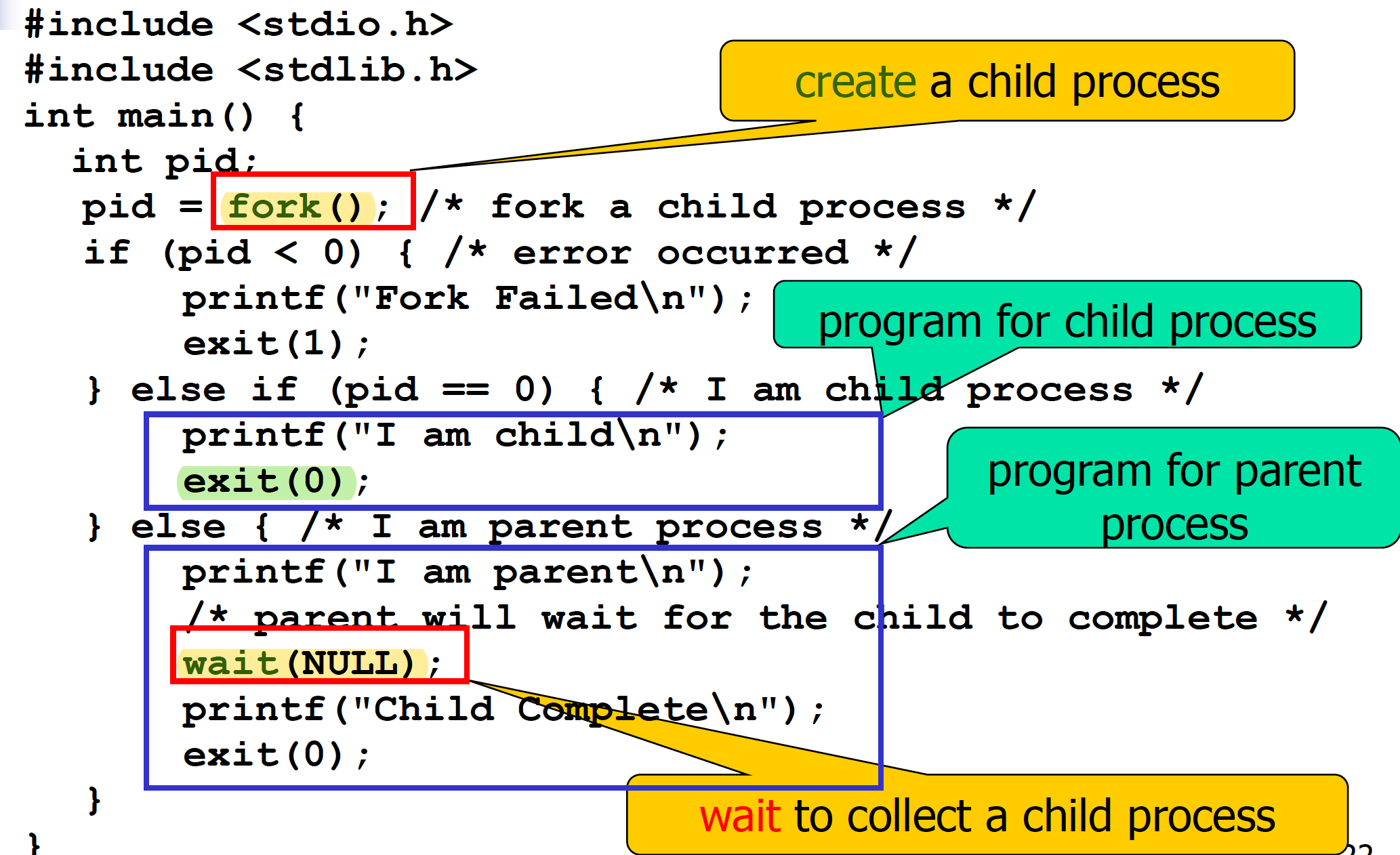
Relationship between parent and child:
- Resource sharing
- Parent and child share no resources.
- Execution
- Parent and child execute concurrently.
- Address space
- Child duplicates that of parent.
- Child may have an independent program loaded into it, with special exec system calls.
- Child duplicates that of parent.
Parent is informed about the completion of a child. Parent should wait for a child to collect it.
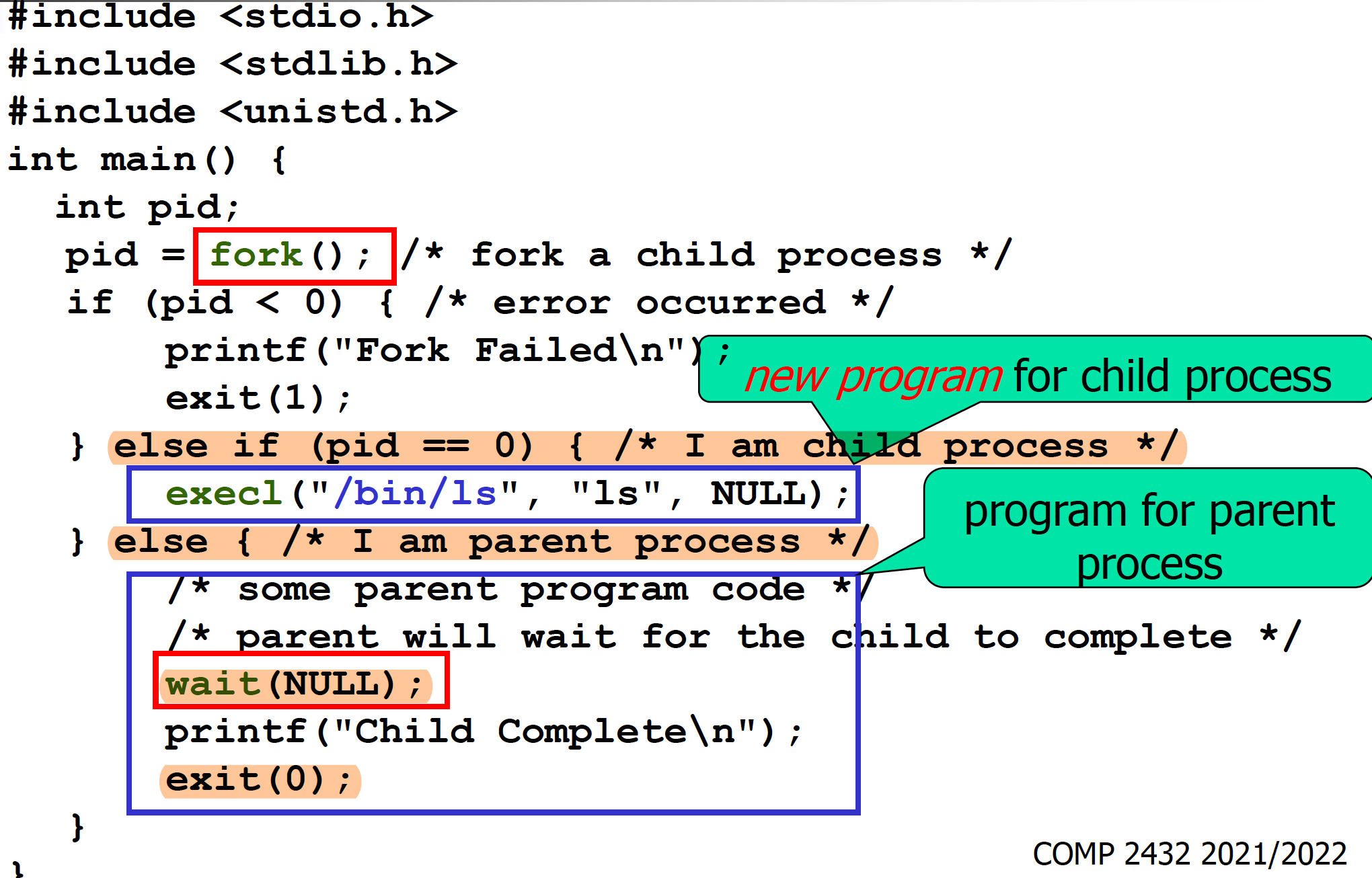
Process Termination
After a process executes its last statement, it asks the OS to terminate it by calling exit.
It passes return data back to parent process via wait.
Parent may terminate the execution of children processes by calling abort if
Child has exceeded usage of resources beyond its allocation.
Task assigned to child is no longer required.
Parent itself is exiting.
有些操作系统不允许一个子进程继续下去,如果它的父进程终止了,子进程也将被终止。
一个已经完成的子进程没有被它的父进程收集或接走,被称为僵尸进程。僵尸进程消耗PCB.
一些操作系统允许特殊安排的子进程在父进程终止后继续运行。
一个没有父进程的进程被称为孤儿进程。
In Unix/Linux
Recall that we have mentioned about process termination arrangement in Unix/Linux.
- Parent should be informed about the completion of a child.
- Parent should wait for a child to collect it.
如果父方不等待子方完成,如果父方在子方完成之前完成,子方将成为孤儿(没有父方)。另一方面,一个完成的子进程如果没有被父方收集或接走,则称为僵尸(活着的死人)。
So wait is necessary.
The exec family
- The exec family of system calls allow a Unix/Linux child process to execute another program (instead of the parent program).
- Include header file unistd.h (#include <unistd.h>).
| System call | Feature |
|---|---|
| int execl**(const char *path, const char *arg0, ...);** | Execute a program at pathname path, last argument must be NULL. |
| int execlp**(const char *file, const char *arg0, ...);** | Execute a program named by file, last argument must be NULL. |
| int execle**(const char *path, const char *arg0, ..., char *const envp[]);** | Same as execl, but access environment variables via *envp[]. |
| int execv**(const char *path, char *const argv[]);** | Same as execl, but arguments are stored in *argv[] instead. |
| int execvp**(const char *file, char *const argv[]);** | Same as execlp, but arguments are stored in *argv[] instead. |
| int execve**(const char *path, char *const argv[], char *const envp[]);** | Same as execv, but access environment variables via *envp[]. |
A non-zero return value indicates an error from system call.
- List of arguments in execl, execlp and execle are terminated by a NULL pointer.
- The path is a string containing the file name, including the full path, to be executed.
- The second argument arg0 is the name of the program for execution, e.g. “ls”.
- For execlp and execvp, the first argument is a file name instead of the path name.
- If the string contains a "/", it is considered as a path name. Otherwise, it is a file name and the system will search for the file according to the directories in environment variable PATH.
- For execv, execvp and execve, arguments for the program are packed within *argv[].
- For execle and execve, there is a final argument *envp[] storing the environment variables and values for the program.

Unix和Linux中对孤儿的特殊安排。
- 一个孤儿进程将被一个新的父进程收养。
- 愿意成为所有孤儿进程的新父进程的特殊进程的pid为1。 它是init进程。
- pid为0的进程是用于分页的交换器,pid为1的进程是用于启动和关闭Unix的第一个运行进程。
在上面的例子中,一个进程有它的父进程1(见第三列PPID)。
- 一个学生进程正在做一些事情,但不知何故从未完成(仍在运行),但该会话的原始shell进程已经终止(注销)了
- 注意,在 CentOS Linux 上,进程1被称为systemd(即系统守护进程),而不是init.
- Process 1在MacOS上被称为 launchd(即启动守护进程),而不是init。
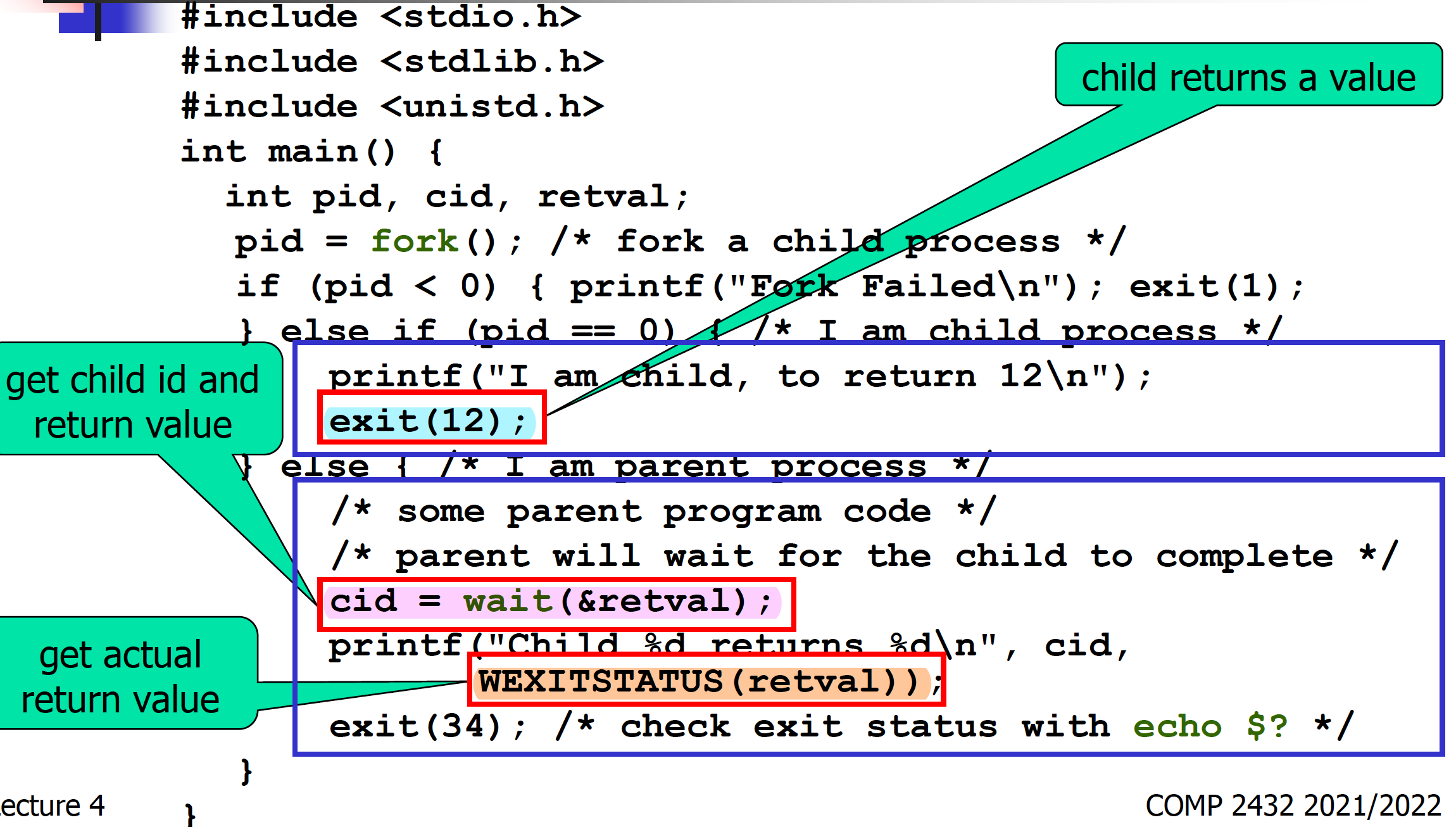
Cooperating Processes
- 一个独立的进程不能影响或被另一个进程的执行所影响。
- 一个合作的进程可以影响或被另一个进程的执行所影响。
- 大多数较大的系统有一个相互合作的进程集合。
- Web server and web browser (client) pair is a form of cooperating processes, residing over the network at different computers.
进程合作的优点:
- 信息共享:并发访问数据.
- 计算速度加快:分解成进程的子任务.
- 模块化:更好地结构化功能.
- 方便性:在并发工作模式下建立一个用户模型。
A very common view point of cooperating processes is the model of a producer and a consumer.
Interprocess Communication
- Producer process produces information (called item) that is consumed by a consumer process.
- Information (item) produced by producer must be stored up for consumer usage later (since consumer may not be running at the same speed as producer).
Producer-consumer problem is related to a problem to coordinate producer(s) and consumer(s), especially when the buffer to hold the intermediate data is not unlimited.
- Producer could store data into a shared array or shared queue and consumer takes it out there.
- Shared array is like the board and everyone can see and draw.
- Producer may send a message containing the data to consumer for consumer to read.
- Message is like an SMS and only the pair knows
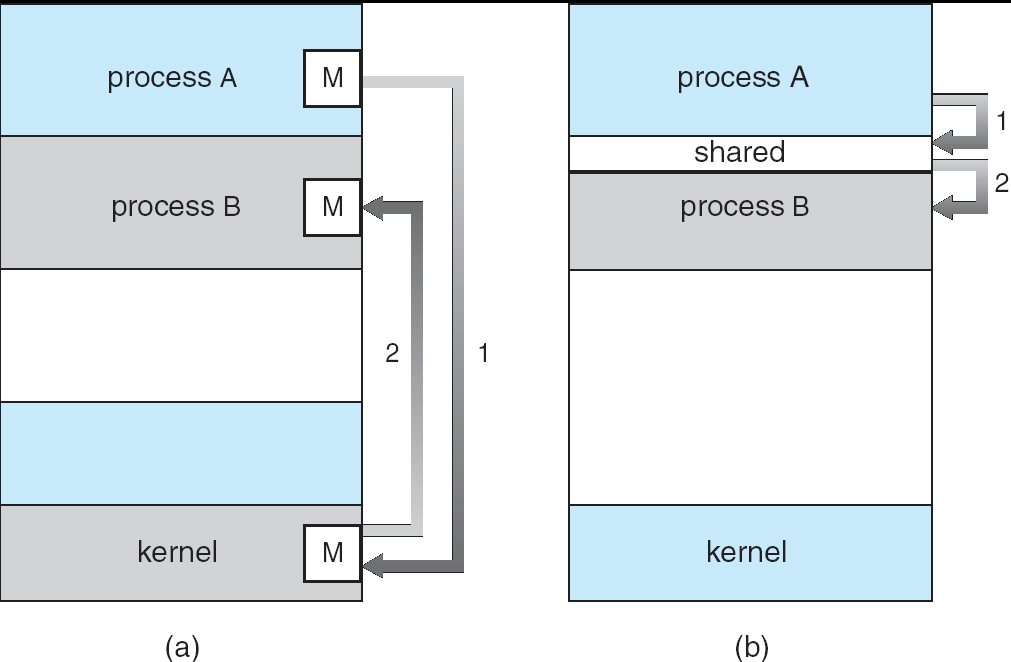
合作进程进行通信和同步行动的机制
- 共享内存系统:进程通过读/写共享变量进行通信。
- 消息传递系统:进程之间通过传递信息进行通信,不使用共享变量。
Interprocess communication (IPC) normally refers to message passing approach with two operations: send(message), receive(message).
- If process P and Q wish to communicate, they need to establish a communication link between them and exchange messages via send/receive.
- Communication link could be physical (e.g., shared memory, hardware bus) or logical (e.g., channel or socket).
Synchronization
Concurrent access to shared data by cooperating processes (or threads) may make data inconsistent.
同步确保共享一个逻辑地址空间的合作进程的有序执行,以保证数据的一致性。
- Synchronization requests processes to wait for the signal to go ahead, to avoid the race condition.
- Examples include sleeping barber problem, reader-writer problem, society room problem.
